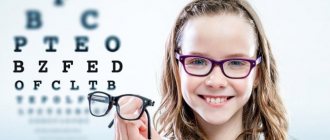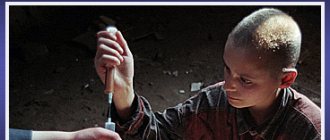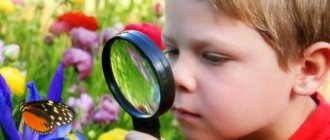Early childhood neuropathy syndrome
Clinical manifestations are most noticeable before the age of two, then they become less pronounced and transform into neuropsychic and autonomic pathologies. Infants experience increased excitability, anxiety, screaming, crying, and interrupted sleep. Attachment to the breast calms the baby for a short time; refusal to feed is not uncommon. After eating, excessive regurgitation, colic occur, and stool disturbances are possible. The formation of circadian rhythms is slowed down: frequent and short sleep during the day and wakefulness at night remain. Characterized by increased susceptibility to noise and changes in illumination, startling during sleep. Waking up is accompanied by crying. Children have a hard time with loneliness and prefer to be in the arms of an adult.
In early childhood, increased anxiety and restlessness are manifested by excessive mobility, stereotypical movements and actions. Children rock to the sides, suck their fingers, and bite their nails. High mobility and lack of coordination lead to falls and bruises, which increases the child’s crying and anxiety. Dysfunction of the gastrointestinal tract, caused by immaturity of autonomic coordination, combined with increased emotional arousal, causes refusal of complementary foods, bloating, nausea, vomiting, diarrhea and constipation. Possible disturbances in the act of swallowing, chewing, selectivity in food up to the refusal of all foods except one or two.
With changes in weather and atmospheric pressure, children's well-being worsens - vegetative disorders intensify, weakness, headaches, tearfulness, and moodiness appear. Seasonal colds and infections are difficult to tolerate. When body temperature rises, seizures and other neurological disorders occur. In the sphere of social interactions, contradictory situations are determined. On the one hand, the child wants to play with peers, asks to go for a walk, to the playground, or to visit. On the other hand, a large number of unfamiliar stimuli - children's screams, noise, tactile contacts - quickly tires, increases excitability, and provokes hysteria. Children with early neuropathy syndrome feel better at home, in a narrow circle of close relatives. They are strongly attached to their mother, prefer to spend time with her, and do not like to be alone.
If you find signs of childhood nervousness in your child, consult a child psychologist for recommendations on providing comprehensive assistance.
Childish nervousness
Mental infantilism (psychophysical immaturity, which, if improperly raised, leads to a delay in age-related socialization)
The main sign is that the child’s behavior and judgment correspond to a younger age.
- True or simple infantilism:
naivety, maladjustment, vulnerability, cheerfulness and goodwill combined with serenity, imprudence and imprudence. Difficulties in mastering norms of behavior and communication, a pronounced predominance of “I want” over “I cannot” and “I must.” The ability to correctly assess the situation, foresee the consequences of one’s actions, and predict the course of events suffers. Rich natural emotionality is superficial, not reaching the level of mature feelings. When faced with a school environment, there is a risk of hysterical neurosis. - General psychophysical immaturity of the infantile type, harmonious infantilism
: retardation of not only mental, but also physical development. The child looks younger than his age: miniature, fragile, weak, but at the same time mobile, graceful and dexterous. Most often affectionate and obedient. Calmly accepts himself as he is. Therefore, neurosis is unlikely. - “Educated infantilism”
is entirely due to the influence of microsocial factors: infantilization in upbringing, artificial delay in age-related socialization, and the consolidation of unadaptability to life. The child grows up selfish, capricious, demanding of the environment, but not of himself, which is a prerequisite for the formation of hysterical character traits.
In contrast to borderline mental retardation in mental infantilism, cognitive activity and parameters of psychospeech and psychomotor development correspond to age standards.
Mental retardation (MRD, borderline mental retardation)
Manifests itself in borderline intellectual failure, with general preservation of higher mental functions. The preconditions of intelligence suffer the most: scattered and unstable attention, insufficiency of voluntary memory, weak mental activity, rapid exhaustion under mental stress. There is low cognitive motivation, weak volition in educational activities, but at the same time, unlike mental retardation, the ability to learn is preserved. Such children are characterized by limited and fragmented ideas about the world around them, naivety, suggestibility and increased dependence on other people. They prefer manual labor and mechanical, visual, concrete activities in which they are easier to achieve success.
Hyperdynamic syndrome
(attention deficit hyperactivity disorder)
Manifests itself from a very early age in restlessness, motor disinhibition and distractibility, a tendency to overexcitation and impulsivity; later - in the superficiality of interests and unpredictability of actions. With more severe brain damage, aggressiveness is possible. Such children are most at risk of rejection from others, which can provoke bitterness, protest behavior and aggressive reactions in them. Dysarthria and dysgraphia are often noted. The peak manifestation of the syndrome is 6-7 years with reverse development in favorable conditions by 14-15 years. With improper upbringing, there is a risk of pathocharacterological development of personality (“acquired” psychopathy). If the course is unfavorable, the situation worsens at 11-13 years.
Hypodynamic syndrome
Manifests itself in severe lethargy and lethargy. Muscles are hypotonic, weakened. The child is awkward, clumsy, unemotional, and intellectually passive: it is difficult to interest him in something or quickly switch to a new type of activity. As a result of timely and well-thought-out educational interventions, by the age of 10-13 the child begins to self-stimulate. As a result of overexertion, constant criticism and ridicule, neurasthenia may develop.
Neuropathy (congenital childhood nervousness)
There are two types of neuropathy:
- excitable
(motor disinhibition, mobility, impulsiveness, hot temper, selfishness, restlessness) and - asthenic
(impressionability, vulnerability, touchiness, tearfulness, exhaustion).
There are mixed options. A child suffering from neuropathy is characterized by physical infantilism, somatic weakness, a tendency to allergic reactions, underdevelopment of a number of body systems and functions, the presence of exudative-catarrhal diathesis and vegetative-vascular dystonia. May be observed:
- Sleep disorders: sensitivity and restlessness.
- Feeding disorders: refusal to breastfeed from 1.5 months, aggressiveness (biting the breast), fatigue during feeding, regurgitation, vomiting. Poor appetite lasts up to 7-8 years.
- Disorders of urination and defecation (frequency or retention, nocturnal enuresis, constipation).
- Contrast of behavior: combinations of timidity, timidity and fearlessness, desperate imprudence, vulnerability and conflict, harmfulness and ingenuity, shyness and importunity, exhaustion and sensory hunger.
- Emotional instability: mood swings.
- Extreme mobility.
- Accelerated psycho-speech development and formation of orienting functions.
- Overexcitability of the autonomic nervous system, allergic predisposition and weather dependence.
- Hypersensitivity (“Princess and the Pea”) and increased irritability.
- Violation of thermoregulation.
- Predisposition to bad habits.
- Affective-respiratory attacks are possible.
In a favorable environment, the condition improves and normalizes by 8-11 years. Under unfavorable micro-social conditions, the risk of neuroticism is high.
Psychogeny (functional neuropsychic disorders in which there are no morphological changes in the substance of the brain, its liquor spaces, membranes and vessels)
There are two types of psychogenies:
1. Psychoreactive states
- disruptions in the functioning of the cerebral cortex due to overstrain of irritative and inhibitory processes.
They develop in response to severe emotional stress associated with the direct action of a psychogenic “blow”, causing shock, fear, anxiety, disappointment, resentment, anger, depression and melancholy. They proceed according to the ancient mechanisms of “motor storm” or “imaginary death”, accompanied by a temporary regression of the psyche. Predisposing factors are psychopathic character traits, somatic diseases, infections, intoxication, vitamin deficiency, traumatic brain injuries, autonomic dystonia, and prolonged insomnia. Distinctive criteria: the determining role of the psychotraumatic factor in the occurrence, picture and course of the disease state; a psychologically understandable connection between the traumatic situation and the content of the reaction; fundamental reversibility of the disorder. 2. Neuroses
– disturbances of integration in the mental sphere, functional disorganization of the personality. They arise as a result of contradictions in particularly significant life relationships. The decisive role in the clinical picture is played by internal conflict (the collision of positions of consciousness and unconscious attitudes, the struggle of social attitudes and temperament, the opposition of claims and unconscious self-esteem), which generates anxiety, pessimism, emotional instability and contrasting behavior, sharpening the instinct of self-preservation to the degree of painful egocentrism and fear.
Types of neurotic conflicts
:
- Neurosthenic conflict:
subjective claims (“I can,” “I want”) and social demands (“I must”) versus subconscious self-esteem (“I can’t,” “It won’t work out”); the problem of “being among others.”
- Hysterical conflict:
egoistic desire (“I want” or “I don’t want”) versus social demands (“impossible” or “must”) and evaluations (“shameful,” “ugly”); the problem of “being yourself among others” with an emphasis on “being yourself”
- Obsessive-psychasthenic conflict:
subjective (“I want” or “should”) versus subjective (“indecent” or “dangerous” and therefore “don’t”); the problem of “being yourself”.
- Phobic conflict:
subjective (“I want”) and social (“I need”) versus the subconscious (“dangerous” and “scary”); the problem of "being". With neurasthenia, the child experiences a feeling of self-rejection, distrust of his abilities and capabilities, which gives rise to indecision, depression, helplessness and isolation. In adapting to the demands of reality, attitudes dominate: “I am weak and can’t do anything,” “I am sick and have the right to leniency, so leave me alone.” Self-doubt, timidity and low self-esteem, causing feelings of shame and guilt, paralyze and exhaust the child: he quickly gets tired, becomes passive, capitulates to difficulties and does not try to overcome them. Irritable weakness manifests itself - excessive reaction to minor reasons, vulnerability, incontinence of emotions, impatience, vanity, increased excitability and rapid exhaustion.
- With hysterical neurosis
the dominant attitude is “it doesn’t matter, it will happen, in my opinion.” The means of liberation or achieving what you want is an imaginary illness. Adaptation occurs through the influence of the unconscious sphere of the psyche on the physiological functions of the body with the recreation of the symptoms of a particular disease. Hysterical reactions are always aimed at someone. At the same time, the child himself is sincerely convinced that he is seriously and chronically ill.
- Obsessive neurosis
(neurosis of obsessive states that are not subject to volitional regulation) begins with anxious suspiciousness, a tendency to obsessive experiences: fear of illness, death, mistakes and accidents. The instinct of self-preservation is heightened, everything new and unknown causes anxiety and fear. Adaptation to life occurs in the form of a desire for over-security and over-control. It manifests itself in the development of obsessive ritual actions that are symbolically protective in nature: they protect against possible and imaginary threats or are an unconscious way of self-punishment for a mistake. Such children are distinguished by their hypersociality: they are disciplined, meticulously obligatory, and alarmingly cautious.
Children with a reduced level of orientation in the world around them, increased impressionability and suggestibility are predisposed to phobic neurosis Severe fear, perceived by the child as a direct threat to life, provokes a painful exacerbation of the instinct of self-preservation, causing panic states and reactions.
Bad habits (sucking fingers, tongue, clothes, bed linen, biting nails and skin of fingers, fiddling with earlobe, wrapping hair around finger and pulling out hair, shaking head, fidgeting in chair; masturbation)
Depending on the reasons that give rise to them, bad habits are:
- Self-stimulation, a forced replacement of the rhythmic movements necessary for the body, promoting the maturation and synchronization of brain biorhythms.
- Compensation for the lack of maternal attention, understanding, care and affection.
- Compensation for lack of impressions.
- An expression of anxiety, fear, self-doubt, internal mental stress and a ritual of self-soothing, self-comfort, self-encouragement.
- Expression of guilt and self-punishment ritual.
Once established, bad habits begin to distract the child from the learning process and threaten infantilization.
Based on materials:
- A. Shuvalov. Yu. Postnikova
Children's nervousness: sources, manifestations, qualified help.
M.: Publishing House "First of September"









